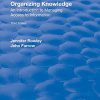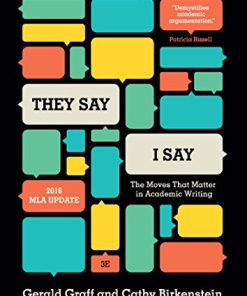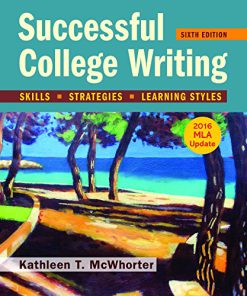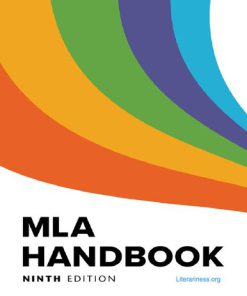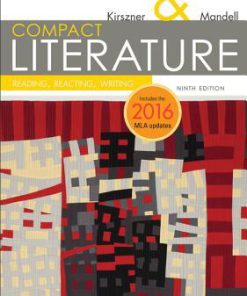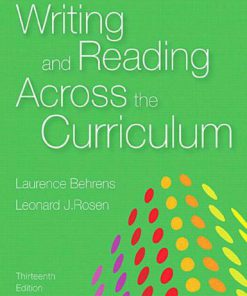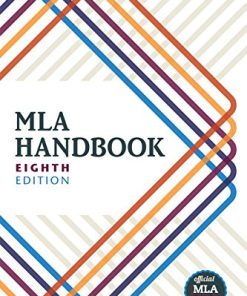Little Brown Handbook The MLA Update 1st edition by Fowler , Aaron , Greer 013477065X 9780135571316
$50.00 Original price was: $50.00.$25.00Current price is: $25.00.
Little Brown Handbook The MLA Update 1st edition by H. Ramsey Fowler Aaron Greer – Ebook Instant Download/Delivery ISBN: 013477065X,9780135571316
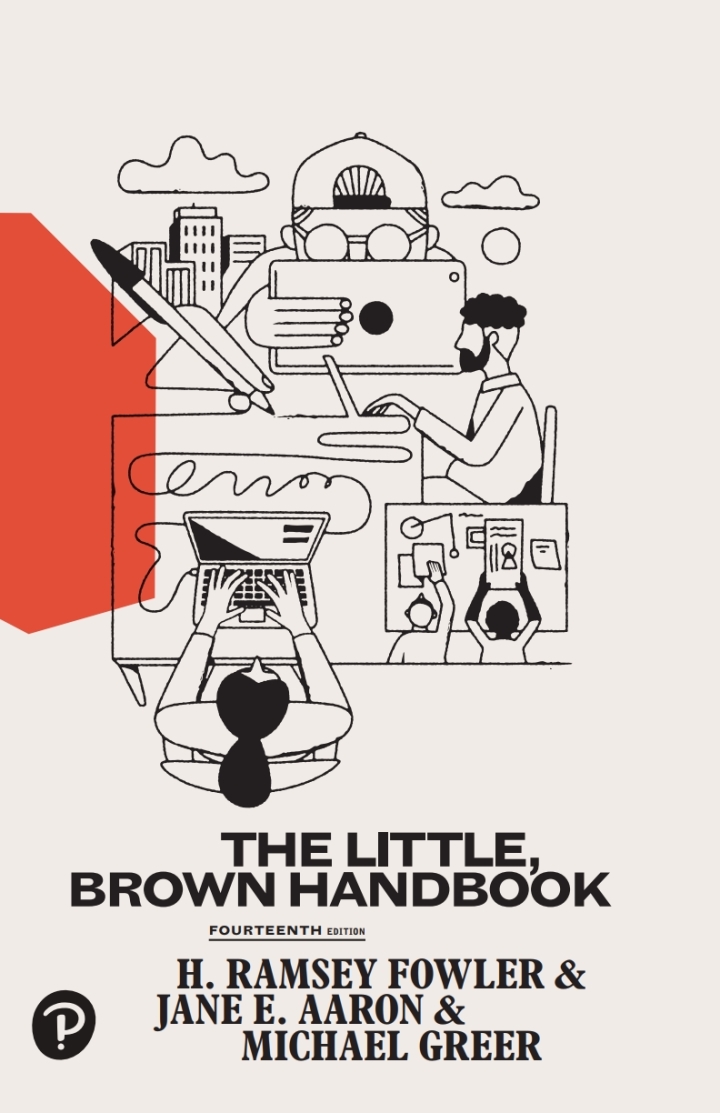
Product details:
Table of contents:
Part 1: The Process of Writing
Chapter 1: Assessing the Writing Situation
1.1. How Writing Happens
1.2. The Writing Situation
1.3. Audience
1.4. Purpose
1.5. Subject
1.6. Genre and Medium
Chapter 2: Discovering and Shaping Ideas
2.1. Invention
2.2. Thesis
2.3. Organization
Sample Informative Essay
Chapter 3: Drafting, Revising, and Editing
3.1. First Draft
Sample First Draft
3.2. Revising
3.3. Peer Review
3.4. Sample Revision
Sample Revised Draft
3.5. Editing
3.6. Final Draft
Sample Final Draft
Chapter 4: Writing and Revising Paragraphs
4.1. Flow
4.2. Unity
4.3. Coherence
4.4. Development
4.5. Introductions, Conclusions, and Transitions
Chapter 5: Presenting Writing
5.1. Academic Writing
5.2. Visuals and Media
5.3. Writing Online
Sample Literacy Narrative Blog Post
5.4. Oral Presentations
Sample Presentation Slides
5.5. Portfolios
Part 2: Reading and Writing in and out of College
Chapter 6: Writing in Academic Situations
6.1. Purpose and Audience
6.2. Genre
6.3. Writing with Sources
6.4. Academic Language
6.5. Communication in Academic Settings
Chapter 7: Critical Reading and Writing
7.1. Critical Thinking
7.2. Techniques of Critical Reading
7.3. Summarizing
7.4. Critical Response
7.5. Visual Analysis
7.6. Writing a Critical Analysis
7.7. Sample Critical Responses
Sample Critical Analysis of a Text
Sample Critical Analysis of a Visual
Chapter 8: Reading Arguments Critically
8.1. The Elements of Argument
8.2. Claims
8.3. Evidence
8.4. Reliability
8.5. Assumptions
8.6. Language and Tone
8.7. Fallacies
8.8. Visual Arguments
Chapter 9: Writing an Argument
9.1. Subject
9.2. Thesis, Purpose, and Audience
9.3. Reasoning
9.4. Evidence
9.5. Engaging Readers
9.6. Organizing and Revising
9.7. Sample Argument
Sample Proposal Argument
Chapter 10: Taking Essay Exams
10.1. Preparing
10.2. Planning
10.3. Writing
Sample Essay Exam Answer
Chapter 11: Public Writing
11.1. Social Media
11.2. Letters and Memos
Sample Business Letter
Sample Memo
11.3. Job Applications
Sample Job Application Letter
Sample Résumés
11.4. Reports and Proposals
Sample Report and Proposal
11.5. Community Service
Sample Social-Media Post
Part 3: Grammatical Sentences
Chapter 12: Understanding Sentence Grammar
12.1. Sentence Basics
12.2. Sentence Patterns
12.3. Single-Word Modifiers
12.4. Word Groups
12.5. Compound Constructions
12.6. Inverted Order
12.7. Sentence Types
Chapter 13: Case of Nouns and Pronouns
13.1. Subjective, Objective, and Possessive Cases
13.2. Compound Subjects and Objects
13.3. Common Questions about Case
Chapter 14: Verbs
14.1. Verb Forms
14.2. Easily Confused Verb Forms
14.3. Verb Endings
14.4. Helping Verbs
14.5. Verbs with Gerunds and Infinitives
14.6. Verbs with Particles
14.7. Verb Tenses
14.8. Sequence of Tenses
14.9. Subjunctive Mood
14.10. Active and Passive Voice
Chapter 15: Agreement
15.1. Subject-Verb Agreement
15.2. Unusual Word Order
15.3. Subjects Joined by Conjunctions
15.4. Indefinite and Relative Pronouns
15.5. Collective and Plural Nouns
15.6. Pronoun-Antecedent Agreement
Chapter 16: Adjectives and Adverbs
16.1. Functions of Adjectives and Adverbs
16.2. Comparative and Superlative Forms
16.3. Double Negatives
16.4. Nouns as Modifiers
16.5. Determiners
Part 4: Clear Sentences
Chapter 17: Sentence Fragments
17.1. Identifying Fragments
17.2. Correcting Fragments
17.3. Common Types of Fragments
17.4. Acceptable Fragments
Chapter 18: Comma Splices and Fused Sentences
18.1. Identifying Comma Splices and Fused Sentences
18.2. Correcting Comma Splices and Fused Sentences
Chapter 19: Pronoun Reference
19.1. Clear Reference
19.2. Close Reference
19.3. Specific Reference
19.4. Appropriate You, Who, Which, and That
Chapter 20: Shifts
20.1. Types of Shifts
20.2. Person and Number
20.3. Tense and Mood
20.4. Subject and Voice
20.5. Direct and Indirect Quotations and Questions
Chapter 21: Misplaced and Dangling Modifiers
21.1. Clear Placement
21.2. Limiting Modifiers
21.3. Squinting Modifiers
21.4. Separated Subjects, Verbs, and Objects
21.5. Separated Infinitives and Verb Phrases
21.6. Position of Adverbs
21.7. Order of Adjectives
21.8. Dangling Modifiers
Chapter 22: Mixed and Incomplete Sentences
22.1 Mixed Grammar
22.2. Mixed Meaning
22.3. Incomplete Compounds
22.4. Incomplete Comparisons
22.5. Careless Omissions
Part 5: Effective Sentences
Chapter 23: Emphasizing Ideas
23.1. Subjects and Verbs
23.2. Subject Beginnings and Endings
23.3. Parallel Elements
23.4. Repetition and Separation
23.5. Conciseness
Chapter 24: Using Coordination and Subordination
24.1. Coordination
24.2. Subordination
24.3. Connecting Words
Chapter 25: Using Parallelism
25.1. Understanding Parallelism
25.2. Equal Elements
25.3. Coherence
Chapter 26: Achieving Variety
26.1. Sentence Length and Structure
26.2. Sentence Beginnings
26.3. Word Order
Part 6: Punctuation
Chart: Commas, Semicolons, Colons, Dashes, and Parentheses
Chapter 27: End Punctuation
27.1. Period
27.2. Question Mark
27.3. Exclamation Point
Chapter 28: The Comma
28.1. Uses of the Comma
28.2. Main Clauses Linked by Conjunctions
28.3. Introductory Elements
28.4. Nonessential Elements
28.5. Series and Coordinate Adjectives
28.6. Quotations and Other Conventional Uses
28.7. Unnecessary Commas
Chapter 29: The Semicolon
29.1. Main Clauses without Coordinating Conjunctions
29.2. Main Clauses with Transitional Words
29.3. Main Clauses That Are Long or Contain Commas
29.4. Items in a Series
29.5. Unnecessary Semicolons
Chapter 30: The Apostrophe
30.1. Possession
30.2. Contractions and Abbreviations
Chapter 31: Quotation Marks
31.1. Direct Quotations
31.2. Titles of Works
31.3. Words Used in a Special Sense
31.4. With Other Punctuation
Chapter 32: Other Punctuation Marks
32.1. Colon
32.2. Dash
32.3. Parentheses
32.4. Brackets
32.5. Ellipsis Mark
32.6. Slash
Part 7: Mechanics
Chapter 33: Capitals
33.1. Conventions
33.2. First Word of a Sentence
33.3. Titles and Subtitles
33.4. Proper Nouns and Proper Adjectives
Chapter 34: Italics or Underlining
34.1. Titles of Works
34.2. Foreign Words and for Emphasis
Chapter 35: Abbreviations
35.1. Abbreviations in Nontechnical Writing
35.2. Misuses of Abbreviations
Chapter 36: Numbers
36.1. Numerals and Words
36.2. Dates and Addresses
Part 8: Effective Words
Chapter 37: Using Appropriate Language
37.1. Standard English
37.2. Texting and Electronic Shortcuts
37.3. Slang, Colloquialisms, Regionalisms, and Jargon
37.4. Indirect or Pretentious Writing
37.5. Sexist and Biased Language
Chapter 38: Using Exact Language
38.1. Dictionary, Thesaurus, and Spelling Checker
38.2. Denotation and Connotation
38.3. Abstract and Concrete Words
38.4. Idioms
38.5. Figurative Language
38.6. Trite Expressions
Chapter 39: Writing Concisely
39.1. Achieving Conciseness
39.2. Subjects and Verbs
39.3. Empty Words and Phrases
39.4. Unnecessary Repetition
39.5. Other Strategies
Chapter 40: Spelling and the Hyphen
40.1. Common Spelling Problems
40.2. Spelling Rules
40.3. Spelling Skills
40.4. Hyphenating Words
Part 9: Research Writing
Chapter 41: Planning a Research Project
41.1. The Process of Research Writing
41.2. Research Questions
41.3. Research Strategies
41.4. Working Bibliographies
Sample Annotated Bibliography Entry
Chapter 42: Finding Sources
42.1. Search Strategies
42.2. Reference Works
42.3. Books and Periodicals
42.4. Web Search Strategies
42.5. Social Media
42.6. Government Publications
42.7. Visuals and Media
42.8. Primary Research
Chapter 43: Working with Sources
43.1. Interacting with Sources
Sample Annotated Source
43.2. Evaluating sources
43.3. Synthesizing Sources
43.4. Summary, Paraphrase, and Quotation
43.5. Integrating Sources
Chapter 44: Avoiding Plagiarism
44.1. Defining Plagiarism
44.2. Information You Do Not Need to Cite
44.3. Information You Must Cite
44.4. Documenting Sources
44.5. Copyright and Permissions
Chapter 45: Writing the Paper
45.1. Developing a Thesis
45.2. Organizing Your Ideas
45.3. Drafting a Research Paper
45.4. Revising and Editing
45.5. Preparing a Final Draft
Chapter 46: Using MLA Documentation and Format
46.1. In-text Citations
46.2. List of Works Cited
46.3. MLA Paper Format
Chapter 47: Two Research Papers in MLA Style
47.1. Sample Research Paper in MLA Style
“The Dream of Sustainable Agriculture”
47.2. Sample Literary Research Paper in MLA Style
“Intersecting Race and Gender in Angelia Weld Grimké’s Rachel”
Part 10: Writing in the Academic Disciplines
Chapter 48: Reading and Writing about Literature
48.1. The Methods of Literary Analysis
48.2. Writing Assignments in Literature
48.3. The Tools and Language of Literary Analysis
48.4. Citing Sources When Writing about Literature
48.5. Writing a Literary Analysis
Sample Literary Analysis
Chapter 49: Writing in Other Humanities
49.1. Methods and Evidence
49.2. Common Writing Assignments
49.3. Tools and Language
49.4. Documenting Sources
49.5. Paper Format
Chapter 50: Writing in the Social Sciences
50.1. Common Genres in the Social Sciences
50.2. Research Conventions in the Social Sciences
50.3. In-text Citations in APA Style
50.4. References in APA Style
50.5. Research Paper Format in APA Style
50.6. Sample Research Paper in APA Style
“Perceptions of Mental Illness on College Campuses”
Chapter 51: Writing in the Natural and Applied Sciences
51.1. Methods and Evidence
51.2. Common Writing Assignments
51.3. Tools and Language
51.4. CSE Style
51.5. Paper Format
51.6. Sample Paper
People also search:
little brown handbook 9th edition
my little brown book lead sheet
the little brown handbook 12th edition
little brown handbook
the little brown handbook 14th edition pdf free
You may also like…
Reference - Writing
MLA Handbook 9th Edition by The Modern Language Association Of America 1603293515 978-1603293518
Reference - Writing
Reference - Writing
dictionaries & phrasebooks
MLA Handbook 9 e 9th Edition The Modern Language Association
Politics & Philosophy - Anthropology
Compact Literature: Reading, Reacting, Writing, 2016 MLA Update Laurie G. Kirszner
Reference - Writing
Writing and Reading Across the Curriculum MLA Update Edition Thirteenth Edition Laurence Behrens
Reference - Writing
Reference - Writing
MLA Handbook Eighth Edition The Modern Language Association Of America
Education Studies & Teaching - School Education & Teaching


